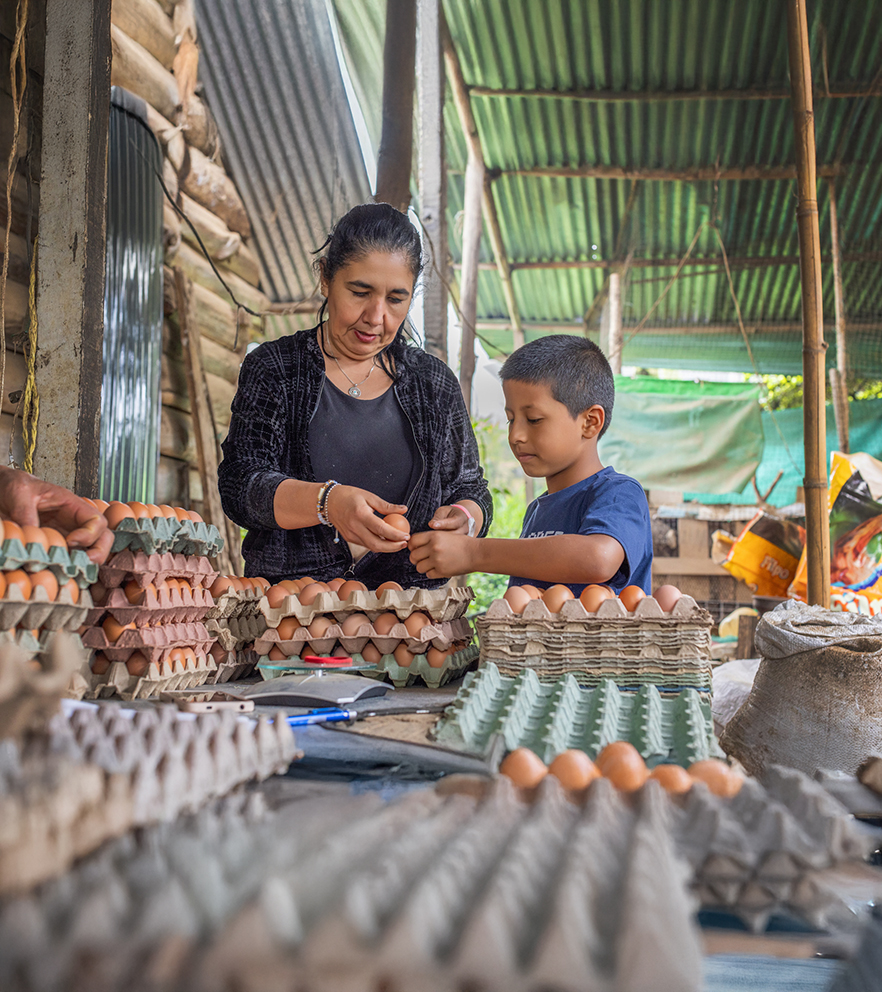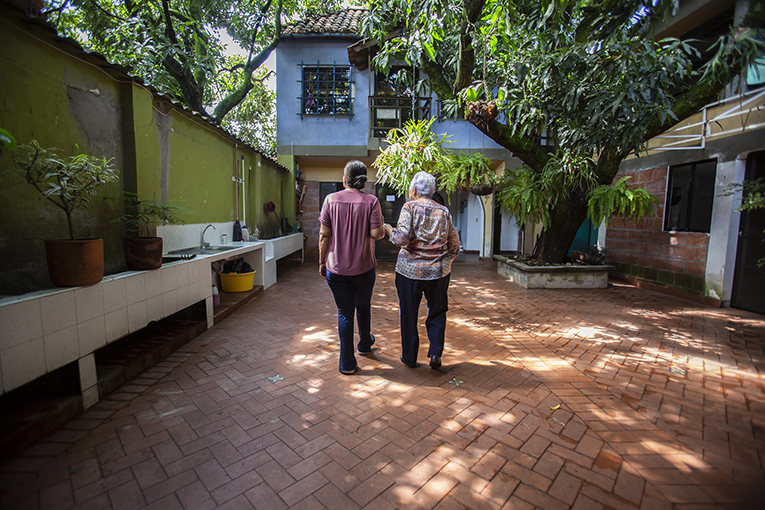Why do so many women no longer want to be mothers? Being a woman, a mother, and a breadwinner: an unequal equation; the outlook in the country and in the Valley

More and more households in Colombia are headed by women, but they also face greater gaps: less income, food insecurity, and greater overburden. This situation is taking shape across the country, but it is becoming more pronounced in Cali and Valle del Cauca.
A gender-sensitive analysis of the Dane Quality of Life Report, conducted by the WWB Colombia Foundation, an organization based in the capital of Valle del Cauca, reveals how these inequalities are leading more women to choose not to become mothers.

Women and mothers struggle in their homes. Photo: WWB Colombia Foundation
While birth rates are falling in Colombia and around the world, little is discussed about the real conditions of those who are already mothers, caregivers, and householders. In Colombia, this reality has a female face. In many cases, the decision to have—or not to have—children is related to deep socioeconomic gaps, a lack of support networks, and a clear deterioration in the well-being of female heads of household.
According to last year's National Quality of Life Survey (DANE), female-headed households are growing steadily. In 2015, they represented 36.4% of the total, and by 2024, they reached 46.5%, an increase of more than 10 percentage points in less than a decade. Between 2023 and 2024 alone, the number increased from 8.2 to 8.5 million households.
This trend demonstrates a transformation in the country's family structure and raises urgent questions: How do these women and their families live? What conditions are limiting their well-being? And what barriers do they face when deciding whether they want—or can—be mothers?

Women and mothers struggle in their homes. Photo: WWB Colombia Foundation
The WWB Colombia Foundation's Analytics Unit conducted a gender-based analysis of the results of the DANE survey in its report, "Being a Woman, Mother, and Breadwinner in Colombia: An Unequal Equation," which exposes a stark truth: female heads of household face a sustained decline in their quality of life, while the proportion of those who no longer wish to be mothers is increasing.
"This analysis stems from the concern that today there are more households dependent on women, who also have more responsibilities and less income, which leads to impoverishment and a reduced opportunity for their children to thrive. And in this unequal equation, the country loses," says Esneyder Cortés, Director of Planning and Strategy at the WWB Colombia Foundation.
Women and mothers struggle in their homes. Photo: WWB Colombia Foundation
Approximately 24.6 million people live in the 8.5 million female-headed households in Colombia, or almost half the country.
Although male-headed households remain the majority, at 54% , female-headed households have grown rapidly since the pandemic. Most of these women are single and without a partner: 65.2% face economic and caregiving responsibilities alone. In contrast, the majority of male heads of household live in two-parent settings (68.3%), with real possibilities of sharing these burdens.
According to the WWB Colombia Foundation, 68.9% of women in Cali, with 42.6% of the 268,000 microbusinesses—this equates to more than 114,000 active women's initiatives—not only generate income, but their ventures are the main source of income for their households. They contribute more than 50% of family income, directly impacting the lives of approximately 122,000 people in the city.
A panorama that reveals a persistent reality of economic inequality. According to the most recent data from the National Statistics Institute (DANE), 37.7% of female heads of household live in monetary poverty, compared to 29.5% of male heads of household. Furthermore, they have a higher multidimensional poverty rate, reflecting accumulated deficiencies in education, health, employment, and housing.
This inequality translates into greater difficulty in covering the basics: 39% of these women lack the money to meet their essential needs. While the average monthly income of households in Colombia is COP $1.3 million, those headed by men reach COP $1.4 million, and those headed by women barely reach COP $1.2 million.
The feminization of poverty remains intact Beyond the numbers, there is the women's own perception of their situation. Forty-two point three percent of female heads of household consider themselves to be living in poverty, and 44.3% say their situation has worsened compared to previous years. This perception reflects a difficult economic reality, a deterioration in their overall well-being, and a decline in their life satisfaction.
Precariousness isn't just material: it also translates into exhaustion, dissatisfaction, and frustration in an environment that demands more than it offers.
According to the WWB Colombia Foundation's analysis, another variable that reflects the feminization of poverty is food insecurity. In 2024, more than 2.4 million female-headed households faced situations where there was not enough food, and 1.1 million of them went without food.
Furthermore, 44.1% of these households in the country—expressed concern about food shortages, a proportion 7 percentage points higher than that recorded in households headed by men.
Furthermore, food insecurity worsened across multiple dimensions. 37.9% of households reported consuming a limited variety of foods (an increase of 5 percentage points), 35.7% lacked access to healthy and nutritious options, and 21% were forced to skip at least one meal per day. Furthermore, 27.7% reported eating less than necessary, and 12.9% experienced complete food shortages.
"These data reveal persistent economic precariousness and invite us to consider the structural causes that restrict income-generating opportunities in female-headed households. One of the most determining factors has to do with how these women allocate most of their time and the types of activities they can pursue," the report states.
According to the National Time Use Survey, in Colombia, women spend, on average, 4 hours and 38 minutes more than men on unpaid care work, and 1 hour and 20 minutes less on income-generating work. This gap has a direct impact on their economic autonomy, personal well-being, and their ability to escape poverty.
While 79.2% of male heads of households devote their time primarily to paid work and only 9.7% perform household chores, the reality among female heads of household is different: only 47.3% are able to focus on productive activities, and 45.2% continue to shoulder the majority of unpaid domestic work.
“This historically unequal distribution perpetuates a cycle of overburden and exclusion that affects women and the overall well-being of their families. This isn't a philosophical reflection, but rather an economic and development one, as it limits economic autonomy, mental health, and the ability to break out of the cycle of poverty,” explains Esneyder Cortés.
Why do so many women no longer want to be mothers? In Colombia, as well as in the Cauca Valley , women who head households had their first child, on average, at age 21.
Nine out of 10 became mothers between the ages of 14 and 28, and more than 34,000 became mothers before the age of 14. Female leadership not only reflects structural gaps; it is also marked by decisions made in vulnerable conditions. Being a mother at a stage when many are still financially dependent on others limits their autonomy and perpetuates cycles of poverty that are difficult to break.
The relationship between early motherhood and economic hardship is clear. 59.6% of women who became mothers between the ages of 10 and 13 report that their income does not cover their basic expenses. Among those who had children between the ages of 14 and 28, the proportion is 42.8%. In contrast, only 28.8% of those who postponed motherhood until after age 29 experience this situation. Early mothers also face higher rates of informality, less access to the contributory health system, and low pension contributions, which compromise their well-being throughout their lives.
The drop in Colombia's birth rate confirms a new reality. In 2024, 445,011 births were recorded, the lowest figure in more than two decades and the first time since 1998 that it has fallen below half a million. According to DANE (National Statistics Institute), this represents a decrease of 13.7% compared to 2023 and 32.7% compared to 2015.
Piedad Urdinola, director of Dane, explains that "these figures represent a historic drop since this entity began keeping vital statistics. While this phenomenon, known as the demographic transition process, began slowly in the 1970s, it accelerated after 2015. Economic instability is one of the main reasons why families postpone having children. Furthermore, we found that the average age at which women become pregnant is 27.1 years, while the average age at first birth is 24.4 years, which demonstrates the postponement of motherhood."
Meanwhile, the National Demographic and Health Survey (2025), prepared by the Ministry of Health and Social Protection, indicates that three out of four women in Colombia do not want to have children, and only one in six expresses interest in motherhood. This change is not only due to personal decisions, but also to adverse structural conditions: precarious access to employment, care overload, and lack of shared responsibility. Among younger women, the refusal to have children is even more pronounced.
The country's population structure is changing: there are fewer children between 0 and 4 years old and more older people, posing enormous challenges for health systems, social protection, and the economy. In 2015, 69.5% of women of childbearing age said they did not want to have children; today, that proportion reaches 75.2%.
“Reducing the debate to personal choices obscures the impact of gender gaps, the lack of guarantees for economic development, and the burden of care work. In contexts where access to decent employment, healthcare, education, and social protection is limited, it's not a whim that many women prioritize their economic autonomy. It's a rational and legitimate response to an environment that restricts their options,” states the report "Being a Woman, Mother, and Breadwinner in Colombia: An Unequal Equation," by the WWB Colombia Foundation.
Black and Indigenous Women: When Inequalities Accumulate Black and Indigenous Women: When Inequalities Accumulate
Being a woman and head of household in Colombia involves much more than leading a home: it means facing unequal conditions that are exacerbated when other factors such as ethnicity, disability, age, or location come into play.
Sixty-five percent of indigenous women and 59% of Afro-descendant women heads of households say their income is not enough to cover basic needs. Added to this is a high perception of poverty: 74% of indigenous women and 68% of Afro-descendant women consider themselves to be in this situation.
Food insecurity is also particularly acute: 69% of Indigenous households headed by women report concern about a lack of food, as do 61% of Afro-Colombian households and 53% of those with people with disabilities. Unpaid labor continues to fall disproportionately on women.
Nearly 50% of Afro-descendant, indigenous, or disabled female heads of household are primarily engaged in household chores, and less than half can access formal employment as their primary activity.
Check out other news of interest 
The remains of the fourth of the five trapped miners. Photo:
eltiempo





